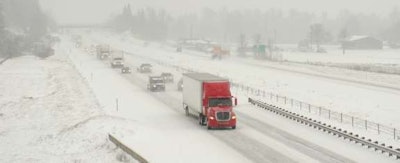
Winter weather can bring extra dangers, especially to truck drivers spending hours on the road at a time. While it’s best to avoid hazardous conditions, you may not always have a choice. No matter where your route takes you, you need to be prepared and know how to drive safely with snow or ice.
“Across the board, it’s a stormier season. We tend to have more cold fronts, more chances for rain, more chances for snow,” says John De Block, warning coordination meteorologist with the National Weather Service.
Even drivers in areas of the country that don’t often see severe winter weather, such as warmer Southern states, should be aware of the dangers the season can bring, even if they don’t look like much.
“A little snow can cause big problems,” De Block says, adding that driving on wet roads is not the same as driving on snow.
He also says that when a winter storm watch is issued, conditions are favorable for another 36-48 hours, so it’s possible to choose a new route that will take you through a safer area or drive to your next destination before you decide to stay put until the harsh weather passes. Winter storm warnings and winter weather advisories pose a more imminent threat.
“Ideally, if you can avoid those areas where those advisories and warnings are issued, I would encourage you to do that,” De Block says.
Here are a few other things you should know before driving in winter weather:
- Prepare first
Before you even begin driving, make sure your truck has been inspected and is in the best condition possible. Update your supplies with any winter-specific items like an ice scraper, a snow brush, and extra food and blankets. If your route takes you through states where tire chains are necessary, attach them before you leave.
- Always check weather conditions
“The number one thing that comes to winter weather is information. You’ve got to stay on top of the weather forecast for where you’re going,” De Block says.
Keep up to date with the changing weather, incoming storms, and road closures through weather apps, the radio, your GPS, or communication with your company. This helps you plan your route and know when to take a different one or when to stay put until it’s safer.
- Keep your distance
It takes longer to come to stop when you’re driving on wet or icy roads, especially when driving a tractor-trailer. Stay further behind other vehicles than normal so you have enough time to stop or react to upcoming hazards if you need to.
- Drive slowly
Speed limits are intended for decent weather conditions. Snow-covered roads mean reduced traction, so you need to make up for it by driving slowly. Reducing your speed also makes it easier to safely stop.
- Pull over if you have to
If the weather is severe and your visibility is hindered, forget your work schedule and pull over until it is safe to start driving again. Nothing you deliver will ever be worth your safety.
- Pay attention to the sun angle
The sun sits lower in the sky during the winter, which can be dangerous if it casts a glare. “It might blind you almost entirely. It might keep you from seeing what a traffic light is doing. It might make it harder to see oncoming traffic,” De Block says.
Sunglasses, your sun visor and a clean windshield can help reduce glare. If possible, choose a route surrounded by tall buildings or trees that help block the sun’s light. However, remember that the more shaded an area is, the more likely it is to remain frozen or wet, even after other parts of the road have dried.
- Watch for black ice
Freezing weather may create a thin layer of transparent ice, making the pavement appear slightly wet. De Block says that being aware of what conditions are likely to create hard-to-spot hazards like black ice is the first priority when driving in the winter.
“Number one is expecting it. And then number two is just being an attentive driver,” he says.
Look for gloss and dark patches of the road, as that may be a sign of black ice. Pay attention to the tire spray from the vehicles in front of you. Once it’s stopped, it’s a sign that the road has iced over and extra caution should be taken.
- Avoid sudden braking
Braking suddenly is dangerous on slick winter roads because you’re already dealing with reduced traction due to snow, ice, or water on the surface. You could easily lose control if you slam on the brakes.
- Be careful on bridges
Elevated structures like bridges and overpasses are usually the first to freeze. When the rest of the road is dry, it can be easy to get caught off guard, so approach all bridges and overpasses with caution by slowing down and avoiding sudden brakes and lane changes or you risk losing control of your truck.
- Maintain at least half a tank of fuel
Condensation inside your gas tank is more likely during the winter, which can lead to your fuel lines freezing because of the water droplets. Keeping your gas tank halfway full limits the amount of air and, therefore, the amount of condensation inside your tank. If you’re stranded, the truck can also be kept running for longer providing you extra warmth when you need it most.







